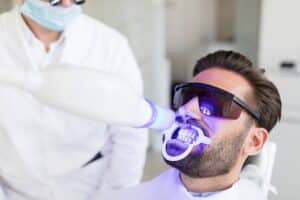You can develop periodontal disease from a large number of factors. What makes it dangerous is that it is almost undetectable in its early stages. Bone augmentation or dental bone grafting is a common remedy for periodontitis, but it’s not the only one. When gum disease becomes serious and infects the sensitive tissue underneath, it leads to periodontitis. It is reversible, but only through expensive surgical options.
The danger of periodontitis
 Periodontitis affects the underlying bone and can cause decay. If you have suffered bone loss, your teeth become loose and start to fall out. The gum tissues die and they start to look decayed and black. In some cases, periodontitis can be fatal. It is easily treatable in the early stages.
Periodontitis affects the underlying bone and can cause decay. If you have suffered bone loss, your teeth become loose and start to fall out. The gum tissues die and they start to look decayed and black. In some cases, periodontitis can be fatal. It is easily treatable in the early stages.
Periodontitis can also develop during tooth decay and tissue inflammation which can occur from infections that have spread through cavities. Regular checkups with your dentist can keep your dental health in check and if you have developed gum disease, it can be easily nipped in the bud.
What to expect during Bone augmentation procedure?
 In case of bone loss, the dentist will have to implement bone augmentation through grafting. This will help build up the bone so that it can support the teeth.
In case of bone loss, the dentist will have to implement bone augmentation through grafting. This will help build up the bone so that it can support the teeth.
The dentist will conduct x-rays and other necessary examinations to confirm which areas of your jaw bone require attention.
- The dentist will conduct x-rays and other necessary examinations to confirm which areas of your jaw bone require attention.
- If there are other cases that have been contributing to bone loss, the dentist will correct that first. This includes cutting away and treating the infected, decaying gum tissue.
- The dentist cannot place replacement teeth until the underlying bone has enough mass to support them. The extra bone is usually taken from the chin and the rear part of your jaw.
- In case the jaw does not have enough bone structure for grafting, the samples are taken from the shin (tibia) or the pelvic bone. Generally, the hip bone is the best candidate for grafting and is preferred by surgeons.
- Bone grafting is a surgical procedure and the patient is put in anesthetic sleep during the operation. Any replacement teeth are added after the grafting process is complete.
Consult with your dental care professional for a more detailed overview on what will suit you best for the augmentation process. Every person is a unique case and therefore, generalization would be unfair. The dentist will review your medical history before deciding on the best course of action.
Recovery and oral care
The most important part of recovering from dental operations is to maintain your dental health. The bone augmentation procedure restores your dental condition to optimum, but a poor hygienic routine will negate all that. You need to follow a good oral care routine to ensure that your teeth remains in ship shape and you do not develop further problems in the future.
You should consult with our dental care professionals @ 817-656-1215 to know more informations about Periodontitis





